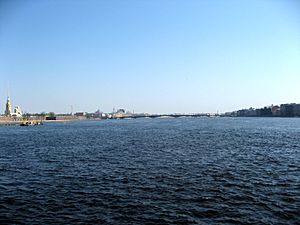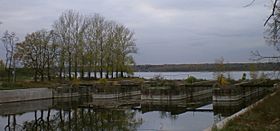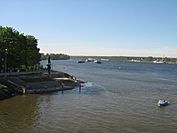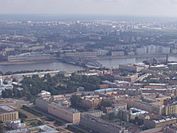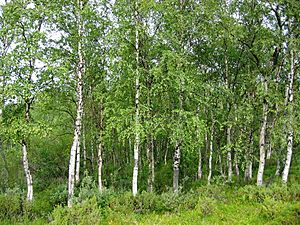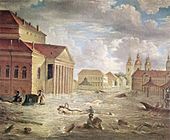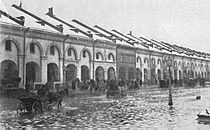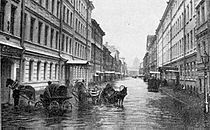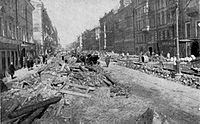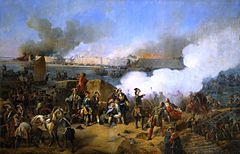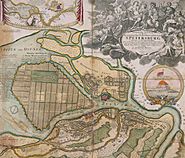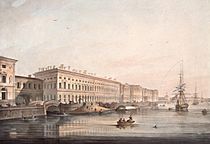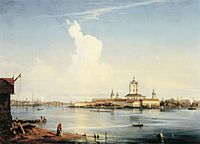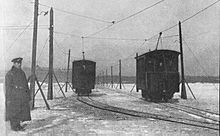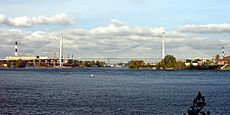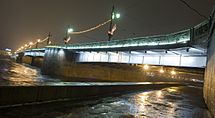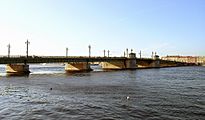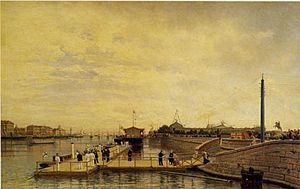Neva River facts for kids
Quick facts for kids Neva River |
|
|---|---|

Lev Lagorio. Moon Night on the Neva (1898).
|
|
| Country | Russia, Finland, Belarus |
| Physical characteristics | |
| River mouth | Neva Bay |
| Length | 74 km (46 mi) |
The Neva River is a short but wide river in northwestern Russia. It is about 74 kilometers (46 miles) long. The Neva flows from Lake Ladoga into the Gulf of Finland. The famous city of Saint Petersburg is built right on its delta.
Contents
About the Neva River
How the Neva River Formed
Long, long ago, about 300 to 400 million years ago, the area where the Neva River is now was covered by a sea! The land we see today was shaped by huge sheets of ice called glaciers. When these glaciers melted and moved away, they left behind a large sea called the Littorina Sea. This ancient sea was much higher than the Baltic Sea is today.
Originally, a different river called the Tosna flowed where the Neva is now. It flowed west into the Littorina Sea. Another river, the Mga, flowed east into Lake Ladoga.
As the land slowly rose, especially near Lake Ladoga, a large lake formed. The water level in this lake kept rising. Eventually, it broke through the land and connected with the Tosna River's valley. This powerful breakthrough created the Ivanovo rapids we see in the Neva today. So, around 2000 BC (or even later, around 1410–1250 BC), the Neva River was born! This makes the Neva a very young river.
The Neva's valley is made of sand and other materials left by the glaciers. It hasn't changed much in the last 2,500 years. The delta of the Neva, where it splits into many smaller channels, wasn't formed by the river dropping off lots of dirt. Instead, it was formed by the river flowing into older layers of sediment.
River Views and Water Flow
The Neva River has many beautiful views as it flows. It's a busy river, especially around Saint Petersburg.
| The mouth of the Ladoga Canal where it meets the Neva. | The Neva River near where the Izhora River joins it. | A view of the Neva River close to the Peter the Great Bridge. |
Plants and Animals of the Neva
The Neva River doesn't have many water plants because its water flows very fast and is quite cold. The river banks are mostly made of sand, peat, and boggy soils.
Hundreds of years ago, the entire Neva area was covered in thick pine and spruce forests. Over time, these forests were cut down for building and other needs, and some were lost to fires. During World War II, many forests were destroyed, especially near St. Petersburg.
After the war, new trees were planted. These included spruce, pine, cedar, Siberian larch, oak, Norway maple, elm, and ash trees. Many types of shrubs also grow here, like barberry, lilac, jasmine, hazel, and rose hip.
Today, the upper parts of the river have forests with lots of birch and pine trees. The middle parts have swampy pine forests. In Saint Petersburg, you can find many lovely gardens and parks along the Neva, such as the Summer Garden and Field of Mars.
Because the Neva's water flows quickly and is cold, not many different kinds of fish live there all the time. Fish that can handle these conditions, like perch, ruffe, and roaches, are common. Other fish, like smelt and vendace, pass through the river at certain times of the year and are important for fishing.
Floods in Saint Petersburg
Saint Petersburg has experienced many floods from the Neva River over the years. These floods can be very serious, covering streets and making it hard to get around.
| A flood on November 7, 1824, in front of the Bolshoi Theatre. | Another view of the flood on November 7, 1824. | Sadovaya Street near the old Nikolsky Market during a flood on November 15, 1903. | Bolshaya Podyacheskaya Street during a flood on November 25, 1903. |
| Boats used for transport on Vasilievsky Island during the flood of September 23, 1924. | Vladimirsky Avenue after the big flood of 1924. | A pier during the flood on October 18, 1967. | Near the Mining Institute on October 18, 1967. |
History of the Neva River
Early History and Battles
The Neva River has been important for a long time, especially for trade and defense. Many historical events happened along its banks.
| Victory of Alexander Nevsky over the Swedes by B. Chorikov. | Assault on the Oreshek fortress on October 11, 1702 by Alexander Kotzebue. | A map showing the Peter the Great Canal from 1742. | An early map of St. Petersburg from 1720. |
The Neva in the Russian Period
After the city of Saint Petersburg was founded in 1703 by Peter the Great, the Neva River became even more important. It was a key waterway for the new capital of Russia. Many beautiful buildings and palaces were built along its shores.
| A view down the Neva River between the Winter Palace and the Academy of Sciences, an engraving from 1753. | The Palace Embankment along the Neva in 1826. | A view of the Smolny Convent from Bolshaya Ohta in 1851. | Trams crossing the frozen Neva River. |
Bridges Over the Neva
Many bridges cross the Neva River, especially in Saint Petersburg. Some of these bridges are "movable" or "drawbridges," meaning parts of them can open up to let tall ships pass through. This is a famous sight in the city!
Bridges in Leningrad Oblast
- Ladozhsky Bridge: Built in 1981, this is a movable metal bridge with many sections.
- Kuzminskii railway bridge: Built in 1940, this is a movable railway bridge with three parts.
Bridges in Saint Petersburg
- Big Obukhovsky Bridge: Built in 2004, this is a cable-stayed bridge that connects two parts of the city.
- Volodarsky Bridge: Built in 1936, this is a movable concrete bridge connecting Narodnaya and Ivanovo streets.
- Finland Railway Bridge: Built in 1912, this is a movable metal railway bridge with two sections.
Bridges in the Neva Delta (Saint Petersburg)
- Alexander Nevsky Bridge: Built in 1965, this is a movable concrete bridge connecting Alexander Nevsky Square and Zanevsky Avenue.
- Peter the Great Bridge: Built in 1911, this is a movable metal bridge with three sections. It connects the old part of St. Petersburg with the Malaya Ohta district.
- Liteyny Bridge: Built in 1879, this is a movable arch bridge with six sections. It connects Liteyny Prospekt with Academician Lebedev Street.
- Trinity Bridge: Built in 1903, this is a movable metal bridge with five sections. It connects Suvorov Square and Trinity Square.
- Palace Bridge: Built in 1916, this is a movable iron bridge with five sections. Its opened central part is a symbol of the city! It connects Nevsky Prospekt with Vasilievsky Island.
- Blagoveshchensky Bridge: Built in 1850, this is a movable iron bridge with seven sections. It connects Labour Square with Vasilievsky Island.
| The Kuzminskii railway bridge. | The Big Obukhovsky Bridge. | The Liteyny Bridge at night. | The Blagoveshchensky Bridge. |
A new movable bridge, the Novo-Admiralteisky Bridge, is planned to be built across the Neva.
Attractions Along the Neva
While many famous places along the Neva are in Saint Petersburg, there are also interesting historical sites upstream in the Leningrad Oblast region.
One important place is the Oreshek fortress. It was built way back in 1323 on Orekhovy Island, right where the Neva River starts from Lake Ladoga. Near the city of Shlisselburg, you can find a monument to Peter I (Peter the Great) on the waterfront. The city also has the Blagoveshchensky Cathedral (built 1764–95) and an old Orthodox church of St. Nicholas (built in 1739) that is still used today.
On the river bank, there's also the Church of the Intercession. This church, built in 2007, is a wooden copy of a historical church that burned down in 1963. That original church was built in 1708 and is thought to be an early version of the famous Kizhi Pogost.
The Old Ladoga Canal was built in the early 1700s. It's a water route that runs along the shore of Lake Ladoga, connecting the River Volkhov and the Neva. Some parts of this old canal are still preserved, like a granite sluice (a water lock) from 1836 and a bridge from 1832.
Images for kids
See also
 In Spanish: Río Nevá para niños
In Spanish: Río Nevá para niños


